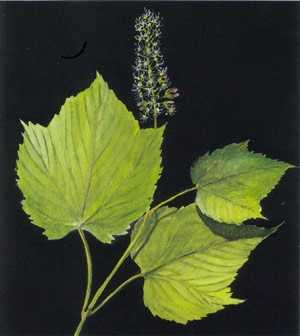
Sometime in June, just after its bright, light green leaves have fully expanded, mountain maple’s delicate, yellow-green flowers begin to bloom. The very un-maple-like, tiny flowers are on long, upright stems, well above the leaves, and they are attractive to insects as well as to people. Striped maple, the other shrub-size maple species in the Northeast, has flowers in drooping clusters that open at about the same time. The big maples – red, sugar, and silver – being mostly wind-pollinated, flowered long ago, when their leaves were just beginning to poke from the buds.
Mountain maple’s mapleness shows clearly as the fruits begin to form. They’re smaller versions of the memorable two-winged samaras that characterize all our maple species, and they turn bright red in July. As the fruits mature, the upright flower stalks bend under their weight, and the ripened samaras hang in bunches. Most of the seeds spiral to the ground in September, but a few stay on to help make mountain maple easy to identify in winter.
Though many seeds are produced, they are not always needed to make a new shrub. Unlike any of our other maples, mountain maple has lateral underground stems that produce shoots and, ultimately, new mountain maples. Even branches can root if they bend to the ground, and this strategy, called layering, is another way mountain maple spreads. More often than not, mountain maple reproduces using one of these vegetative methods instead of from seeds.
And spread it does, sometimes forming a near monoculture in very rocky conditions. Though typically it is confined to the understory, this adaptable shrub also flourishes along roads and streams, on talus slopes, and even on cliffs. Like many shade-tolerant trees and shrubs, it does even better in a sunny setting. Similarly, although it will grow on acid soils, its growth is best in moist, limy situations.
To find mountain maple, look in these habitats for a tall, many-stemmed shrub with thin, grayish-brown bark that is smooth on the small stems and has shallow fissures on larger ones. Mountain maple can grow to 6 inches in diameter, but I don’t think this happens very often. The leaves are opposite, 3 to 4 inches long, and have the familiar 3- to 5-lobed maple shape, coarsely serrated margins, and leafstalks that are longer than the leaves. Prominent veinlets lead to one of the three major veins in each leaf. The undersides of the leaves are downy.
In addition to being at home in a variety of settings, mountain maple also has a large range, including much of the southern part of Canada and most of the northeastern United States. This is good news for many animals.
Being a shrub – usually growing to 12 or 15 feet tall, but sometimes making it to 25 – most of a mountain maple is within browsing distance of a variety of wildlife species. It gets high marks from moose, deer, beaver, and snowshoe hare, which collectively could browse it to the ground. Fortunately for all of them, mountain maple grows back vigorously after being heavily and repeatedly browsed. Reportedly – and remarkably – it produces the greatest amount of new growth when 80 percent of the new twigs are removed each year. If you want more mountain maple, especially if you want it to be within reach of deer, it is recommended that you cut the stems nearly to the ground during the growing season. It is one of the most nutritious browse species for white-tailed deer. Deer also eat the seeds, as do a variety of birds. Ruffed grouse feed on the winter buds.
I check the mountain maples that line an old road near my house frequently during the year. In winter, I’m grateful for the reddish color of the current year’s twigs, which contrasts sharply with the gray older bark, allowing me to identify mountain maple from afar. Of course, everything is beautiful in May as leaves unfold, but June’s mountain maple flowers, perhaps especially because they are often right at eye level, seem unusually lovely. Soon they are followed by fruit more colorful than the flowers, and before long the leaves become orange, yellow, and red – even more colorful than the fruit.


Discussion *